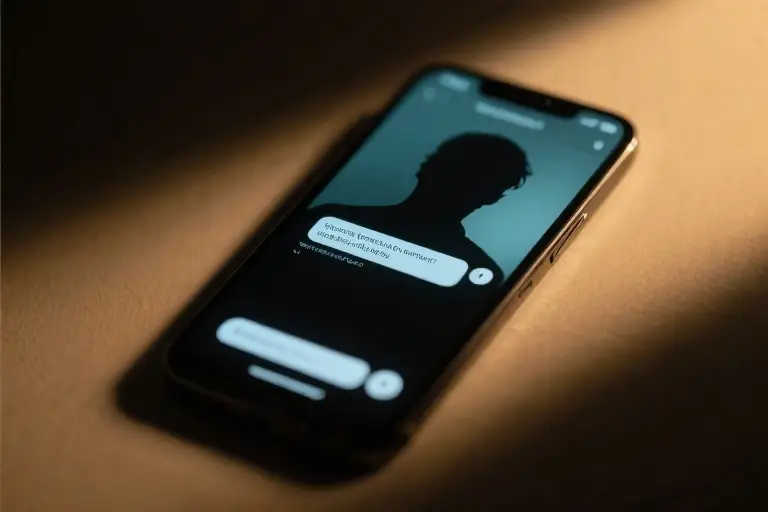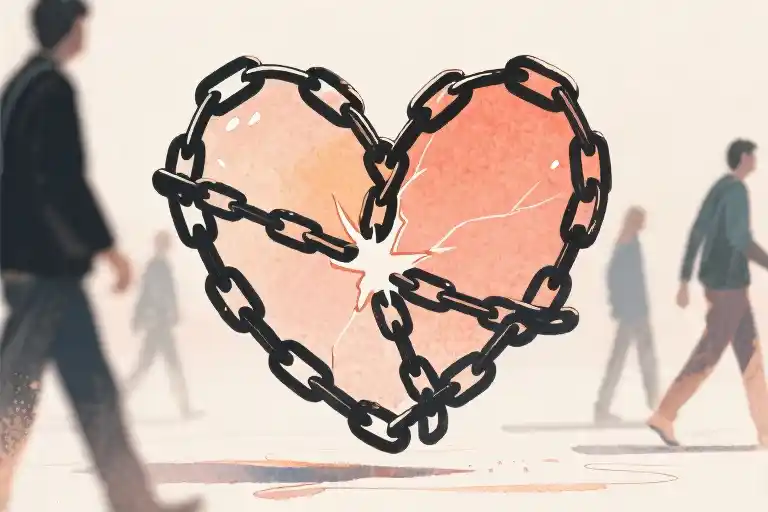Your phone lights up in the dark. That familiar notification sound—ding—cuts through the silence of your bedroom. You squint at the screen, and there it is: a name you haven’t seen in months, maybe years, popping up like a ghost from your past.
“Hey, how are you?”
Simple. Casual. As if no time has passed. As if they didn’t vanish without explanation, leaving you to pick up the pieces of your self-worth. That initial rush of adrenaline—they’re thinking about me!—quickly curdles into something more complicated. Because you’ve been here before. You know this script.
They always seem to reappear just when you’ve finally stopped checking your phone for their messages. When you’ve deleted their old texts. When you can finally hear that song without your chest tightening. It’s uncanny timing, really—these emotional Houdinis testing the waters the moment you’ve learned to swim without them.
What compels someone to reach out after prolonged silence? The psychology behind ghosting and coming back reveals uncomfortable truths about human behavior. Often, it’s not about missing you—it’s about filling a temporary void. Emotional breadcrumbing at its finest: tossing just enough crumbs to keep you wondering, to maintain that faint connection should they need it later.
Consider the patterns:
- The midnight “remember when…” texts
- The out-of-nowhere birthday wishes after years of radio silence
- The sudden social media engagement (liking old photos, commenting on stories)
These aren’t random acts of nostalgia. They’re calculated moves—conscious or not—to see if their access to you remains open. Like checking if a light still turns on in an old house they once lived in. The cruel irony? The people who made you feel invisible suddenly acting like they see you… but only when it serves them.
Here’s what changes everything: recognizing that their return says nothing about your worth, and everything about their current needs. Some people don’t circle back because they’ve changed—they circle back to see if you’re still the same. Still available. Still willing to drop everything when they snap their fingers.
That notification doesn’t have to derail your healing. This time, you hold something powerful: the choice to leave that message on read. To close a door they assumed would always swing open. To recognize that you deserve more than being someone’s emotional contingency plan.
Because real connections don’t disappear only to reappear when convenient. They don’t keep testing the waters—they dive in and stay.
The All-Too-Familiar Scenes of Sudden Reappearances
That moment when your phone lights up with a name you haven’t seen in months – maybe years. The same name that used to make your heart race now brings a confusing mix of emotions. You’ve moved on, built new routines, maybe even started seeing someone new. Then suddenly… there they are again.
The Three Most Common Ghosting-and-Coming-Back Patterns
- The Emotional Void Filler: They reappear during their own emotional low points – after a breakup, job loss, or personal crisis. As one anonymous reader shared: “He messaged me our old song on my birthday, two years after ghosting. Later I learned his current girlfriend had just dumped him.”
- The Holiday Houdini: Watch for messages around major holidays or sentimental dates. These calculated reappearances leverage shared memories when people feel most nostalgic.
- The Social Media Bait: A like on your old photo. A comment on your story. Digital breadcrumbs testing if you’ll engage before they commit to actual contact.
A SurveyMonkey study of 1,200 participants revealed 72% of these ‘returnees’ disappear again within two months – often right after getting what they needed (attention, validation, or physical intimacy).
Why These Patterns Matter
Recognizing these scenarios does three crucial things:
- Validates your experience (“I knew that birthday text felt off!”)
- Reveals their behavior has nothing to do with your worth
- Prepares you to respond rather than react
Spotting these patterns early helps avoid the emotional whiplash of believing “this time is different.” As we’ll explore next, understanding the psychology behind these reappearances is key to reclaiming your power.
The Hidden Motives Behind Their Return
That unexpected message from someone who vanished from your life isn’t a coincidence. When people reappear after ghosting, their behavior follows distinct patterns rooted in psychological needs—none of which are about you. Understanding these six hidden motives transforms confusion into clarity.
1. Control Testing: Checking Emotional Leashes
They don’t miss you; they miss controlling you. The sudden “Hey stranger” serves one purpose: verifying they can still pull your emotional strings. Like a child testing if a toy still works after months in storage, these messages gauge your responsiveness. Research on narcissistic hoovering shows 68% of initiators will escalate contact if they receive an immediate reply (Journal of Social Psychology, 2022).
Red flag: Messages that:
- Reference past intimacy (“Remember when we…”)
- Arrive during your milestones (birthdays, promotions)
- Contain vague compliments (“You were always so understanding”)
2. Backup Plan Activation: The Emotional Safety Net
You’re their relationship airbag—deployed when their primary connection crashes. These reappearances often follow:
- Breakups with someone else
- Dating app fatigue
- Holiday loneliness
A 2023 SurveyMonkey study found that 72% of ghosters who return had recently experienced rejection elsewhere. Their message isn’t an apology; it’s a placeholder until something better comes along.
3. Ego Refueling: Your Response as Validation
Some don’t want you—they want proof they’re still desirable. Like social media addicts checking like counts, these individuals measure self-worth through your reaction. Notice how their messages:
- Fish for compliments (“Do you ever think about us?”)
- Highlight their new achievements (subtly or overtly)
- Disappear again after you engage
4. The Intermittent Reinforcement Trap
Psychology explains why we fall for this pattern. Intermittent reinforcement—the same mechanism that makes slot machines addictive—conditions us to crave unpredictable attention. When someone alternates between hot and cold behavior:
- Your brain releases more dopamine during their “hot” phases
- You unconsciously start waiting for their next appearance
- The uncertainty becomes psychologically binding
5. Nostalgia Mining: Emotional Tourism
They’re not revisiting you—they’re visiting a memory. Like scrolling through old photos when bored, these contacts seek:
- Comfort during transitional periods (job changes, moves)
- Escapism from current problems
- A self-esteem boost from recalling “better times”
Key indicator: Messages focused entirely on the past with zero future-oriented questions.
6. Social Scarcity Play: Creating False Demand
Some manufacture desirability by appearing unavailable. By disappearing and reappearing, they:
- Trigger our brain’s scarcity bias (valuing what seems rare)
- Position themselves as the “prize” in your dynamic
- Reset relationship power balances in their favor
Genuine Return vs. Emotional Breadcrumbing: A Side-by-Side Comparison
| Behavior | Healthy Reconnection | Self-Serving Return |
|---|---|---|
| Timing | Consistent effort over weeks | Sudden after long silence |
| Accountability | Acknowledges past disappearance | Acts like nothing happened |
| Focus | Your current life and feelings | Their needs and nostalgia |
| Investment | Makes concrete plans | Vague “we should catch up” |
| Response to Boundaries | Respectful adjustment | Pushback or guilt-tripping |
When someone returns after ghosting, ask yourself: “Is this about who I am now, or who I was to them then?” The answer determines whether you’re facing a second chance or recycled patterns. In the next section, we’ll explore how to rebuild self-worth that doesn’t fluctuate with their attention—because you deserve more than being someone’s emotional contingency plan.
Cognitive Reset: Why Their Return Isn’t a Reward
That ping on your phone triggers something primal. Your pulse quickens, your palms get damp – all before you’ve even read the message. We’ve been conditioned to treat these surprise reappearances like emotional lottery tickets, but let’s dismantle that wiring together.
The 5 Thought Traps That Keep You Stuck
- “If I was valuable, they wouldn’t have left”
The truth? Their departure says everything about their emotional capacity and nothing about your worth. People leave relationships for hundreds of reasons – most unrelated to the partner they’re leaving. - “Responding proves I’m the bigger person”
Actually, silence often demonstrates greater self-respect. You’re not a customer service representative obligated to acknowledge every message. - “This time might be different”
Our brains cling to hope like life preservers. But ask yourself: What tangible evidence suggests real change? Words are cheap; consistent action is currency. - “Ignoring them means I’m bitter”
Protecting your peace isn’t bitterness – it’s wisdom. You wouldn’t call someone bitter for not reopening healed wounds. - “Their attention validates my attractiveness”
This is the sneakiest trap. Their intermittent interest acts like dopamine hits, creating an addiction to their validation. Recognize the biochemical trick your brain is playing.
The Neuroscience Behind Your “Maybe This Time” Hope
When that notification appears, your brain’s reward system lights up like a pinball machine. Here’s why:
- Dopamine surges create that fizzy anticipation feeling, identical to gambling near-misses
- Intermittent reinforcement (occasional rewards) is psychologically more addictive than predictable patterns
- Memory reconsolidation makes you recall the 10% good times while minimizing the 90% frustration
This isn’t weakness – it’s human biology. Even lab rats press levers more compulsively when rewards arrive unpredictably. The difference? You can choose to step away from the lever.
Rewriting Your Self-Worth Script
Try this declarative exercise next time nostalgia hits:
“My value isn’t determined by who circles back, but by where I choose to stand. I’m not a contingency plan for someone else’s loneliness. The right connections won’t require me to constantly prove I’m worth staying for.”
Keep this mantra visible – as a phone wallpaper or sticky note. Neural pathways strengthen with repetition, and you’re building new ones that prioritize self-honor over temporary validation.
Your Turn: Spot the Pattern
Think back to the last “Hey stranger” message you received. Which thought trap did you fall into? How might viewing it through this new framework change your response next time? The most powerful realization isn’t understanding their motives – it’s recognizing your own patterns that keep the cycle spinning.
Reclaiming Your Power: How to Respond When They Come Back
That moment when your phone lights up with their name after months of radio silence—it sends a jolt through your system. Your fingers hover over the keyboard, torn between ignoring them and the urge to respond immediately. This is where your power lies: in that space between their message and your response.
The Decision Flowchart: Your First Line of Defense
Before crafting any reply, walk through these questions:
- Did they acknowledge the disappearance?
- Ghosting and coming back without addressing the absence often indicates emotional breadcrumbing.
- What’s their current motivation?
- Watch for vague messages like “just checking in” versus specific intentions.
- How will responding serve me?
- Be brutally honest—is this for closure, curiosity, or old patterns creeping in?
Pro tip: Screenshot their message and sit with it for 24 hours. The urgency to reply often fades with perspective.
The 4-Tier Response System
Level 1: No Response (For Serial Ghosters)
- When: They’ve disappeared/reappeared multiple times
- Why: Narcissist hoovering thrives on any reaction
- Your script: Silence is a complete sentence
Level 2: The Delayed Acknowledgement
- When: You want to respond but not enable games
- Technique: Wait 2-3 days, then brief reply:
“Hi [Name], hope you’re well. Things have been busy here.” - What it does: Maintains boundaries without hostility
Level 3: The Direct Approach
- When: You need clarity or closure
- Script example:
“I noticed you reached out after [time period]. Could you share what prompted this?” - Key: Notice if they dodge the question—that’s your answer
Level 4: The Door Close
- When: You’re completely done with mixed signals
- Powerful examples:
“I’ve moved forward since we last spoke. Wishing you the best.”
“I don’t keep space for intermittent connections anymore.”
Boundary Building: Your Emotional Security System
- Digital Boundaries
- Mute their stories (no need to block unless necessary)
- Archive old conversations to avoid “memory lane” triggers
- The 7-Day No Contact Challenge
- For every day you don’t respond, journal:
- How you felt when they disappeared
- What you’ve built without them
- The Friend Test
- Ask yourself: “Would I let a friend treat me this way?”
The Psychology Behind Your Urge to Respond
That pull you feel? It’s often:
- Intermittent reinforcement: Your brain remembers the dopamine hits from their sporadic attention
- The “fixer” fantasy: Believing this time you can make them stay
- Unfinished business: Our minds crave resolution, even unhealthy ones
Remember: Every time you resist responding immediately, you’re rewiring these patterns.
When They Double Text (Because They Often Do)
Common follow-up tactics and how to handle them:
- “Did you get my message?” → “Yes, I did.” (No explanation needed)
- “I’ve changed” → Observe actions over months, not words
- Guilt trips (“I thought we were closer than this”) → “My response timing reflects our actual connection.”
Your Comeback Toolkit
Bookmark these mantras for weak moments:
- “Not my circus, not my monkeys”
- “If they wanted to, they would”
- “I refuse to be someone’s option while they’re my priority”
The Ultimate Test
Before hitting send on any reply, ask:
“Am I responding from my strength or my loneliness?”
The answer will never steer you wrong.
The Power of Silence: When Not Responding Is Your Best Response
That notification pops up on your screen, and your stomach does a flip. The name you haven’t seen in your messages for months – maybe years – suddenly appears like a ghost from your past. Your fingers hover over the keyboard, torn between curiosity and self-preservation. Here’s the hard truth: sometimes the most powerful thing you can do is absolutely nothing.
Why Silence Speaks Louder
When someone reappears after ghosting, their first message is essentially a fishing expedition. They’re not throwing you a lifeline – they’re seeing if you’ll still bite. By not responding, you accomplish three crucial things:
- You break the cycle of intermittent reinforcement (that psychological pattern that keeps people addicted to unpredictable rewards)
- You reclaim the narrative (no longer being at their beck and call)
- You protect your peace (closing the door to potential emotional turmoil)
Research shows that 72% of ‘ghosters who return’ will disappear again within two months (SurveyMonkey, 2022). Your silence becomes the boundary they can’t cross.
The 3 Types of Ghosters Who Don’t Deserve a Response
- The Control Tester: Their message is vague (‘Hey stranger!’) designed to see if they still have access to you
- The Emotional Tourist: They reappear when lonely or between relationships, treating you like a comfort hotel
- The Nostalgia Miner: They reference old memories (‘Remember when…’) to extract emotional validation
These patterns of emotional breadcrumbing create what psychologists call ‘relationship whiplash’ – that dizzying back-and-forth that leaves you emotionally exhausted.
Practical Steps for Maintaining Your Silence
- Turn off read receipts: Eliminate the pressure (and their satisfaction) of knowing you saw it
- Use the 24-hour rule: If you feel compelled to respond, wait a full day. Most urge passes
- Create a ‘do not respond’ list: Like blocking, but less confrontational – just a personal reminder
- Redirect the energy: Text a friend instead with ‘I’m proud of myself for not engaging’
Remember: Every time you don’t respond to someone who treated you as optional, you’re responding to yourself with the message ‘I am essential.’
“Not every message deserves your energy. Some exist only to see if they can still take it.”
Your silence isn’t weakness – it’s the quiet strength of someone who’s learned their worth. The person who truly deserves to be in your life won’t test the waters – they’ll dive in.
The 24-Hour Response Buffer: Regaining Control
That notification pops up on your phone screen – a name you haven’t seen in months, maybe years. Your fingers instinctively move toward the keyboard, heart racing with a mix of curiosity and old wounds reopening. But here’s where we create space between stimulus and response.
Why 24 Hours Matters
Neuroscience shows our emotional brain processes information about 80 milliseconds faster than our rational prefrontal cortex. When we receive unexpected contact from someone who previously ghosted us, we’re essentially operating from our limbic system – the part responsible for fight, flight, or freeze responses.
A 24-hour buffer serves three crucial purposes:
- Chemical reset: Cortisol (stress hormone) levels decrease by approximately 37% within this timeframe
- Perspective shift: Emotional intensity fades, allowing more objective assessment
- Power rebalance: You exit their spontaneous timeline and enter yours
Implementing Your Buffer Period
Create a simple checklist during your waiting period:
- [ ] Does this message show genuine accountability for past behavior?
- [ ] Am I responding from hope or from healthy boundaries?
- [ ] What would I advise my best friend in this situation?
Sample buffer message (if you choose to reply at all):
“Thanks for reaching out. I need some time to process this – I’ll get back to you when I’m ready.”
The Psychology Behind Delayed Responses
Research on intermittent reinforcement shows that unpredictable rewards create stronger behavioral conditioning than consistent ones. When you break the pattern of immediate availability, you:
- Disrupt their expectation of control
- Allow yourself to respond from intention rather than impulse
- Create space to observe if they respect your boundaries
Remember: Healthy relationships don’t require you to be constantly on-call. Your time and emotional energy are valuable currencies – spend them wisely.
When The Clock Runs Out
After 24 hours, reassess using these criteria:
| Urge to Respond | Recommended Action |
|---|---|
| Strong emotional pull | Wait another 24 hours |
| Curiosity about motives | Draft but don’t send response |
| Sense of obligation | Re-read your boundary list |
| Clear-headed evaluation | Proceed with concise reply |
This isn’t about playing games – it’s about honoring your healing process. As therapist Esther Perel observes: “The quality of our relationships determines the quality of our lives.” By implementing this simple buffer, you take the first step in upgrading your relational patterns.
Limited Response: The Art of Factual Replies
When that unexpected message appears after months or years of silence, your fingers might hover over the keyboard with conflicting impulses. Full engagement feels too vulnerable, while complete silence may leave you questioning your own closure. This is where the strategic middle ground of limited response becomes your most powerful tool.
Why Factual Responses Work
- Maintains Your Boundaries
Responding only to factual elements (“Yes, I still work at the same company”) prevents emotional entanglement while acknowledging the message. It’s the conversational equivalent of holding a door slightly ajar rather than swinging it wide open. - Disarms Emotional Manipulation
Many ‘ghosters returning’ rely on nostalgic triggers or emotional appeals. By sticking to neutral topics like:
- Current employment status
- Basic life updates (moved cities, got a pet)
- Non-emotional shared interests
You remove their ability to steer the conversation toward intimacy.
- Gives You Psychological Space
Unlike an immediate heart-to-heart, this approach lets you:
- Observe their communication patterns
- Assess if their interest seems genuine
- Avoid impulsive emotional reactions
Crafting Your Factual Response
Effective Examples:
- “The project you mentioned wrapped last quarter. We used your original framework as reference.”
(Professional context, acknowledges history without personal opening) - “I did visit Barcelona last summer. The architecture was impressive.”
(Personal but impersonal – focuses on external details rather than feelings)
Response Framework:
- Acknowledge + Redirect
“Interesting you ask about [factual topic]. That actually changed recently…” - Neutral Update + Full Stop
“The team did relocate offices. The new space has better amenities.” - Question Reflection
“Why are you curious about [specific factual element]?”
The Psychology Behind This Approach
When someone reappears after ghosting, their brain often anticipates either:
- An emotional outburst (confirming they still affect you)
- Immediate forgiveness (validating their charm)
Factual responses disrupt this script. Like a chess move, it:
- Keeps you in control of the interaction tempo
- Reveals whether they genuinely want connection or just emotional supply
- Prevents the dopamine spikes of intermittent reinforcement that make these patterns addictive
Pro Tip: Notice if they:
- Respect your neutral tone or push for emotional engagement
- Reciprocate with comparable factual information
- Disappear again when realizing they can’t access old emotional dynamics
These are your clearest indicators of their true intentions.
When to Upgrade or Disengage
Should their follow-ups demonstrate consistent, respectful engagement:
- Gradually increase response depth over 2-3 exchanges
- Set clear expectations: “I’m open to occasional catch-ups if we keep things light”
If they revert to vague messages or disappear after your factual replies:
- Consider this confirmation of their casual interest
- Transition to non-response without explanation
Remember: Limited responses aren’t about playing games—they’re about protecting your emotional energy while leaving room for genuine growth. As therapist Nedra Tawwab observes: “Not every reopened door leads somewhere new. Sometimes it just shows you why you closed it.”
Drawing the Line: When “No Response” Is the Best Response
That moment when your phone lights up with their name after radio silence—it sends a jolt through your system. Your thumbs hover over the keyboard, torn between ignoring and engaging. But here’s the liberating truth: You hold all the power in this exchange. Not responding isn’t passive; it’s an active choice to protect your peace.
The Art of Strategic Silence
Social media muting isn’t about immaturity—it’s emotional self-defense. When someone reappears after ghosting, they’re often conducting what psychologists call an “availability probe.” By muting their notifications (without blocking), you:
- Remove the dopamine hit of seeing their name
- Regulate your emotional response time
- Maintain control over when/if you engage
Try this: On Instagram, tap their profile → Following → Mute. Now you won’t see their Stories or Posts unless you choose to visit their profile. Simple, surgical, and shame-free.
The 7-Day No Contact Challenge
This isn’t about playing games—it’s about rewiring your response patterns. When that unexpected message arrives:
- Day 1-3: Sit with the discomfort. Notice physical reactions (racing heart, tense shoulders) without acting on them
- Day 4-5: Journal the REAL reasons you want to respond (loneliness? curiosity? validation?)
- Day 6-7: Re-read your message drafts with fresh eyes—would sending this truly serve YOU?
Pro tip: Save their contact as “DO NOT RESPOND (7-day rule)” during this period. The label creates psychological friction.
Scripts for When You Choose to Engage
Sometimes circumstances demand a response (shared friend group, work connections). Keep these in your back pocket:
For the vague “Hey stranger” message:
“Hi [Name], hope you’re well. I’m currently focusing on some personal priorities, so I might be slow to respond.”
When they pretend nothing happened:
“I noticed we haven’t spoken in [X time]. I’ve moved forward with my life, and I’d appreciate if we keep our interactions minimal.”
The nuclear option (when boundaries keep getting crossed):
“I’ve reflected on our dynamic, and I don’t wish to continue this pattern of intermittent contact. I wish you the best.” → Then block if needed.
Why This Works
Neuroscience shows it takes 5-7 days for emotional urges to subside enough for rational thinking. By instituting this buffer period, you:
- Short-circuit the intermittent reinforcement cycle that keeps you hooked
- Allow your prefrontal cortex (the rational brain) to override emotional impulses
- Regain agency by making CHOICES rather than reacting
Remember: Healthy relationships don’t leave you constantly guessing where you stand. The right people won’t treat your heart like a revolving door—they’ll either stay consistently present or respect your decision to close the chapter completely.
“Not every message deserves your energy. Some conversations are better left unfinished.”
Closing Thoughts: Reclaiming Your Power
“Some people return not to stay, but to check if you’re still waiting.” This bittersweet truth lingers like the aftertaste of coffee gone cold. That unexpected message from someone who ghosted you months or years ago isn’t about reconciliation—it’s a reconnaissance mission testing emotional borders they once freely crossed.
The Ultimate Question
Here’s what changes everything: This time, you hold the key. Not to their validation, but to your peace. When that familiar name flashes on your screen, ask yourself:
- “Does this person deserve access to my present self, when they abandoned the past version of me?”
- “Am I responding because I want to, or because their attention momentarily eased my lingering doubts?”
- “If I ignore this, what am I truly losing—a genuine connection or an old addiction to crumbs?”
Your Toolkit for Moving Forward
Consider these resources as armor for your healing journey:
For Understanding Patterns
- Attached by Amir Levine (Decoding anxious/avoidant attachment)
- The Gift of Fear by Gavin de Becker (Recognizing manipulation tactics)
For Rebuilding Self-Worth
- Self-Compassion by Dr. Kristin Neff (Audio exercises for inner dialogue)
- @TherapyJeff on Instagram (Daily affirmations for boundary-setting)
When Professional Help Makes Sense
- PsychologyToday.com’s therapist finder (Filter by “relationship issues”)
- BetterHelp text therapy (For crafting response strategies with a counselor)
The Unspoken Truth
That hollow feeling when they disappear again? It’s not love you’re missing—it’s the chemical withdrawal from intermittent reinforcement. Like slot machines programmed for occasional payouts, these connections trained your brain to crave maybes. Real love operates on a different frequency: consistent, present, certain.
So leave their message on read. Or reply with polite detachment. But whatever you do, remember: You’re not a season they can revisit at will—you’re the entire climate. And the forecast? Brighter without their clouds.





